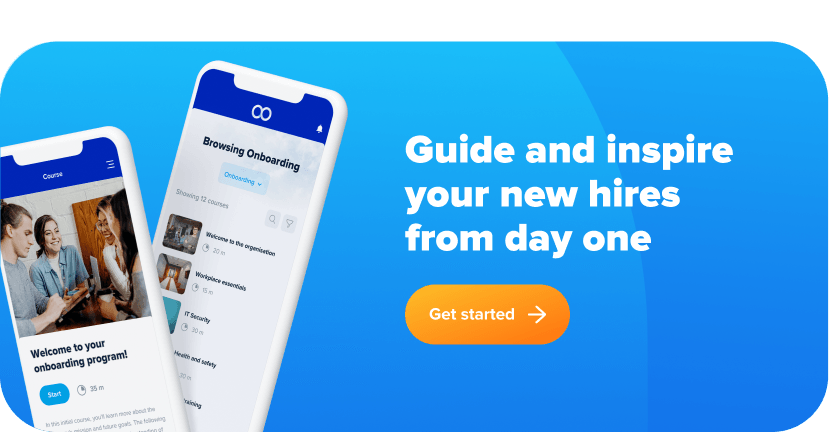What is the employee offboarding process?
Employee offboarding is the process companies use to ensure that departing employees are not only trained on all of the company’s information security policies, but are also effectively removed from their access and systems. This includes exit interviews, knowledge transfers, finalizing payroll paperwork, recovering company assets, updating organizational charts and tying up other loose ends.
However, many HR teams don’t have a process in place. Often an effective offboarding plan is absent because other HR disciplines like onboarding, skills training and career succession planning are in the spotlight. But actually, proper employee offboarding processes are vital for the protection of a company’s information assets and also to recognize valuable team members as they leave the organization.
In this article, we will provide you with a checklist of the top six things that should be taken into consideration when developing an effective employee offboarding process.

Why is offboarding important?
There are several reasons why offboarding has become an even more important skill to master for HR and managers:
- Compliance – When people leave your organization, it can easily become unclear who is taking care of what. But obviously, you want to adhere to employment law requirements and make sure your practice does not cause any privacy and IT security risks. Introducing a streamlined offboarding plan will help your organization’s legal and IT security compliance become more waterproof.
- Frequent job changes – Employees stay in their jobs for a shorter time than before. Frequent job changes mean that staff offboarding will happen more often in your organization and take up more time for HR and managers. Having an effective employee offboarding process will help you increase the quality of your work and save time.
- Feedback – Employees who are about to leave the organization often want to help and feel that they can speak their mind more freely. This means that they can be a valuable source to get honest feedback and ideas for what you can improve.
- Employer branding – With a great offboarding plan in place employees exiting your organization can become valuable ambassadors for your brand, help you attract new candidates through positive mention, and even become boomerang employees.
- Company culture – A sincere and professional employee offboarding as the final chapter in the employee journey is strong proof that your company is living by its values and positively impacts employee wellbeing in the organization.

Onboarding vs offboarding – how do they differ?
Employee onboarding and offboarding are two separate processes, with different goals and different outcomes.
Onboarding is a process of introducing new employees to their new roles and responsibilities in the company, making sure that they have all the information they need to do their jobs effectively.
Offboarding is the opposite: it’s a process of ensuring that outgoing employees understand the details of their separation from the company, from what benefits they’ll be receiving to what paperwork they need to complete.
It’s essentially a way for companies to make sure all compliance, policy and performance bases are covered before an employee leaves.
The ultimate offboarding checklist
Offboarding is primarily focused on closing out an employee’s tenure at the company. The goal is to make sure that everyone involved understands what steps need to be taken—whether it’s a simple matter of forwarding them important information or taking care of more complex tasks like updating any remaining benefits.
To wrap things up smoothly, just as you would have an onboarding checklist, here are we have put together a complete employee offboarding checklist guiding you step by step of the process.
1. Quickly communicate the change
When an employee leaves, there are a few things you need to do to make it a positive experience for them. Even though they’re not a part of your organization anymore, people usually have a certain affection for the company and for the people they worked with. You don’t want that to be marred by how the exit is handled.
The first thing you need to do is communicate the change both quickly and clearly, so there is no room for doubt or confusion. If you have an honest conversation about the change and why it’s needed, you set the tone for a smooth transition into an employee’s departure.
2. Prepare any necessary paperwork
An important step in the employee offboarding process is to get everything in writing from soon-to-be former employees. This can include administrative and human resources paperwork such as a letter of resignation, final payslips, and important employee benefits. Keep in mind that every company is different—you may find yourself needing any combination of these documents depending on your company’s policies such as non-disclosure agreements and others.
For example, you may need to provide them with documentation showing how much vacation time they have left and the policies regarding annual leave encashment or taking days off before their departure.
You might also need to collect documentation from your employees in preparation for paying them their final paycheck. If your company has a 401(k) plan, they’ll need to fill out paperwork so you can process their withdrawal.
3. Jumpstart the knowledge transfer
There are many processes in the employee offboarding process, but one of the most important ones is knowledge transfer. This is the idea of making sure that any knowledge an employee has that may be critical to completing their job or to someone else’s job is transferred to the correct people. While it might seem like this wouldn’t be an issue for most companies, you’d be surprised by how many companies forget about this step.
Knowledge transfer should take place in all employee offboarding processes and should be documented as part of the employee’s exit interview. This helps to ensure that the company is not left with a knowledge gap.
The last thing you want as a manager or business owner is to have your team scrambling at the last minute because essential information was forgotten during the offboarding process.
4. Carry out the exit interview
As part of the employee offboarding process, you should conduct an exit interview to make sure your parting employees are leaving on a positive note.
Exit interviews offer great opportunities to get crucial feedback from your team members or conduct exit surveys, so you can inform and evaluate your company’s policies and procedures as well as improve the employee experience.
If you’re looking for ways to improve your processes, ask them about their experience and what went well during their time at the company. Did any problems arise? Were there parts of the offboarding process that were too long or too short? Did they feel that they had all of the information they needed before they left?
You should also use this time to go over what happened while they were employed—did they learn anything new? Did they move up any career ladders? Did they achieve any milestones with the company?
5. Recover any company assets
Did you know that up to 25% of data a previous employee can access is sensitive data?
When an employee leaves your company, the last thing you want to deal with is getting your assets back. But if you don’t do it, you could end up losing hundreds of dollars of equipment and materials that were paid for by your company.
To ensure that you get all your equipment and materials back, follow this process:
- Put together a list of all company property that needs to be returned (computers, credit cards, laptops, cell phone, employee’s access to softwares or email accounts, etc.)
- Set up a meeting with the leaving employee to go through the list and make sure the person knows what needs to be returned.
- Finally, after the item is returned, complete the offboarding checklist so that all company assets are accounted for.
By following these steps, you can protect yourself from having to spend money on resources that have already been provided by your company.
6. Make it a pleasant goodbye
You may think it’s enough to thank your employee for an interview well done when they’re hired, but an employee’s last day is the time to show them how important they really were to you. And thanking and congratulating them is an important part of the offboarding process.
Employees may feel some sense of regret over leaving the company, even if they have landed a job somewhere else. In many cases, they might be especially excited about their new opportunity, but will still have a soft spot for their time at your company.
It’s important for them to get a sense of how their work was valued by management, and that means letting them know directly what you appreciated about their performance and how they contributed to the overall success of the organization.
Onboard and offboard employees with eloomi
It’s important for HR managers to make sure that terminated employees are aligned with the right offboarding tasks so they can move on with their careers. Be it a small business or a big corporation, having a proper handover and exit process is integral to the HR department.
Employees might be the lifeblood of a company, but it takes some effort to ensure that your company’s blood is flowing smoothly. With eloomi’s employee onboarding checklist and offboarding solution, you can get that blood pumping with a few simple clicks.
eloomi’s employee onboarding tool helps businesses like yours grow your company culture while hiring new employees, keeping existing employees happy and conducting onboarding tasks. With a customizable workflow, eloomi allows you to streamline your pre-boarding and onboarding process for new hires as well as offboard employees on good terms.
Engage with your workforce in a way you never have before. Get started today!







